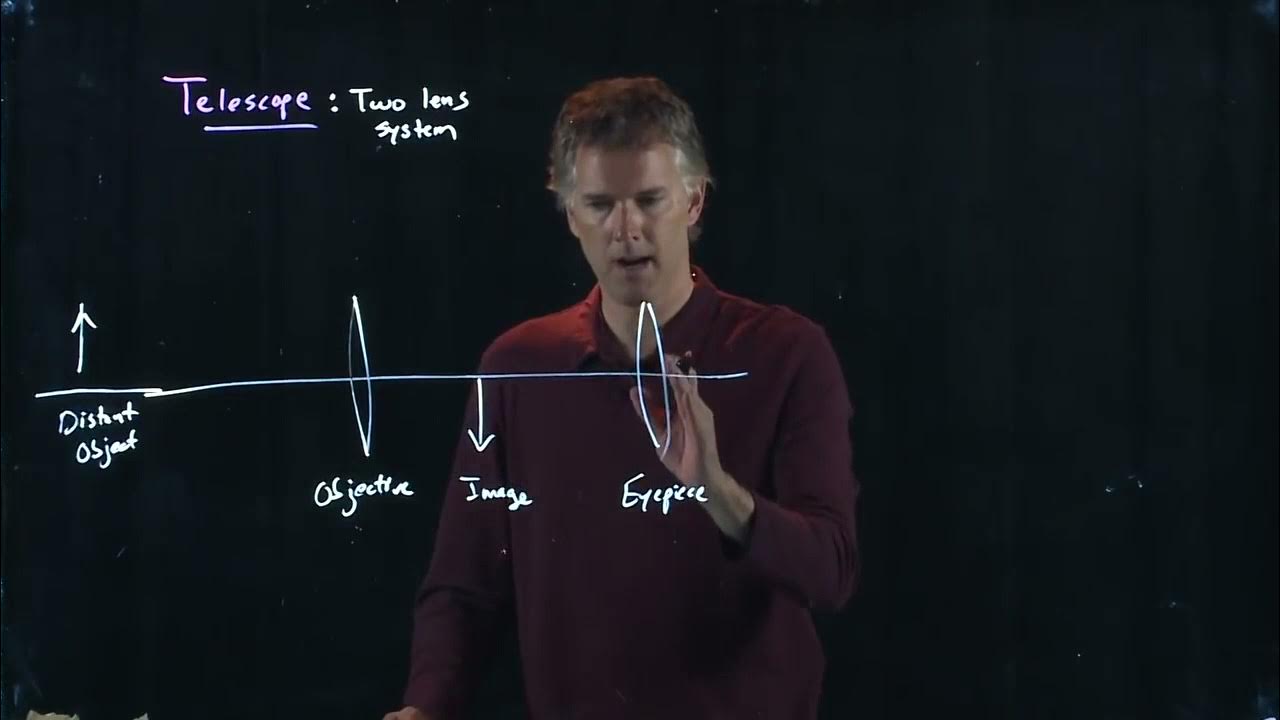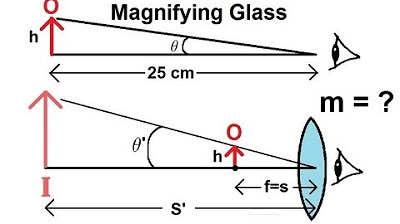The Microscope | Physics with Professor Matt Anderson | M28-12
TLDRThis script delves into the mechanics of a microscope, highlighting its dual-lens system with an objective and an eyepiece. It explains the significance of the tube length (l), the eyepiece focal length (fe), and the objective focal length (fo) in determining the magnification (m) of the system. The formula for magnification is given as m = (-l - fe) * n / fo, emphasizing the importance of short focal lengths for high magnification. The script also touches upon the practicality of microscopes, comparing them to jeweler's loops for close inspection and the impressive magnification capabilities of various microscopes.
Takeaways
- 🔬 Microscopes have two lenses: an objective lens and an eyepiece.
- 👀 The objective lens is located close to the sample, while the eyepiece is what you look through.
- 📏 The length between the objective lens and the eyepiece is known as the tube length, typically around 16 centimeters.
- 🔍 The focal lengths of both the objective lens (Fo) and the eyepiece (Fe) are short, contributing to high magnification.
- 🧮 The magnification (M) of a microscope is given by the formula: M = -(L - Fe) * N / (Fo * Fe).
- 📐 In this formula, L represents the tube length, while N is the near point of the eye, usually 25 centimeters.
- 🔄 Short focal lengths in both lenses allow for significant magnification, often 100x, 200x, or even 500x.
- 🔧 Jeweler's loupes function similarly to microscopes but with a single short focal length lens.
- 🏗️ The orientation and combination of these lenses are crucial for achieving dramatic magnification increases.
- 🔭 Magnifying glasses operate on the same principle but are typically less powerful than microscopes.
Q & A
What is the basic concept of a microscope?
-A microscope is an optical instrument that uses two lenses to magnify small objects, allowing the user to view details of a sample that are too small to be seen with the naked eye.
What are the two lenses in a microscope called?
-The two lenses in a microscope are called the objective and the eyepiece.
How is the magnification of a microscope determined?
-The magnification of a microscope is determined by the formula: m = -(l - fe) / fo, where l is the length of the microscope tube, fe is the eyepiece focal length, and fo is the objective focal length.
What is the typical length of a microscope tube?
-The typical length of a microscope tube is about 16 centimeters, which is determined by the height of the table and the comfortable viewing point for the user.
What is the significance of the eyepiece focal length (fe) in a microscope?
-The eyepiece focal length (fe) is significant because it contributes to the overall magnification of the microscope. A shorter focal length can lead to greater magnification when combined with the objective lens.
What is the role of the objective focal length (fo) in determining magnification?
-The objective focal length (fo) is crucial for magnification because it is the lens closest to the sample. A shorter focal length for the objective lens can result in higher magnification when used in conjunction with the eyepiece.
Why are both the objective and eyepiece lenses in a microscope typically short focal length lenses?
-Both the objective and eyepiece lenses are typically short focal length lenses to maximize magnification. When both lenses have short focal lengths, their effects multiply, resulting in a significant increase in the overall magnification of the microscope.
What is the near point of the eye, and how is it relevant to microscope usage?
-The near point of the eye is the closest distance at which a person can see an object clearly, typically around 25 centimeters. It is relevant to microscope usage because it affects the design of the eyepiece and the comfort of the user when viewing the sample through the microscope.
Can the magnification of a microscope be increased indefinitely?
-No, the magnification of a microscope cannot be increased indefinitely. There are practical limits due to the quality of lenses, the resolution of the optical system, and the need for sufficient light to maintain a clear image.
Why might a jeweler use a single short focal length lens instead of a microscope?
-A jeweler might use a single short focal length lens, such as a jeweler's loupe, for quick and close inspection of small details like those on a ring. It provides a simpler and more portable alternative to a full microscope for such tasks.
What is the practical application of high magnification in microscopes?
-High magnification in microscopes is used in various scientific and industrial fields to examine and study minute details of samples, such as cells in biology, materials in metallurgy, or defects in manufacturing processes.
Outlines
🔬 Microscope Magnification Basics
This paragraph introduces the fundamental concept of a microscope, which uses a two-lens system consisting of an objective and an eyepiece to magnify small objects. The script explains the importance of the tube length (l), the eyepiece focal length (fe), and the objective focal length (fo) in determining the overall magnification of the microscope. It also touches on the idea that a comfortable viewing position influences the length of the microscope tube, which is typically about 16 centimeters. The magnification formula is briefly mentioned, with an invitation for those interested in the derivation to visit the speaker's office for further details.
Mindmap
Keywords
💡Microscope
💡Objective
💡Eyepiece
💡Focal Length
💡Magnification
💡Tube Length (l)
💡Near Point of the Eye (n)
💡Lens System
💡Derivation
💡Jeweler's Loop
Highlights
Microscopes have two lenses: an objective and an eyepiece.
The microscope is a two-lens system used for detailed observation.
The sample is placed at a specific position for optimal magnification.
The housing between lenses has a length denoted by 'l'.
The magnification of the microscope is calculated using a specific formula.
The formula for magnification is m = (-l - fe) * n / fo.
The length 'l' of the microscope tube is typically about 16 centimeters.
The eyepiece focal length 'fe' is very short and can be adjusted.
The objective focal length 'fo' is also short and can vary for different magnifications.
The near point of the eye 'n' is usually around 25 centimeters.
A shorter focal length of both lenses results in higher magnification.
Jewelers use a single short focal length lens, similar to a microscope's objective.
Microscopes can achieve magnifications of 100x, 200x, and even 500x.
The combination of lenses in a microscope dramatically increases magnification.
The magnification formula involves the multiplication of lens focal lengths.
For high magnification, both the objective and eyepiece lenses need to be short focal length.
The comfort of the viewer influences the length of the microscope tube.
Different objective lenses can be rotated for varying magnification levels.
Transcripts
Browse More Related Video

Focal Length of Eyepiece in a Microscope | Physics with Professor Matt Anderson | M28-22

The Telescope | Physics with Professor Matt Anderson | M28-13

Physics 59 Optical Instruments (3 of 20) The Microscope

Physics 59 Optical Instruments (2 of 20) The Telescope

How telescopes work | Class12 (India) | Physics | Khan Academy

Physics 59 Optical Instruments (1 of 20) Magnifying Glass
5.0 / 5 (0 votes)
Thanks for rating: